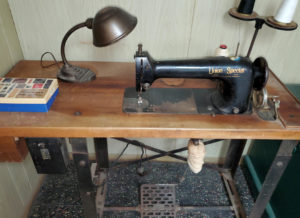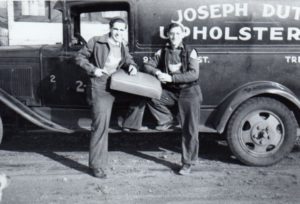By Richard Dutko
Fall 2022 Newsletter
[ Editor’s note: Our bicycle and sewing machine collections can yield hundreds of donated items by a wide range of individuals in the greater tri-state area of New Jersey. Each item we collect has a backstory. During our collections we sometimes get to hear snippets of these stories. I always enjoy these tales as it helps me put into perspective the scope of our mission and injects a more personal connection to the otherwise inanimate objects we send overseas.
The story that follows is from a donor that I was able to speak with via email about a large industrial sewing machine dating back to the 1930s. The history and personal story behind this machine gets me incredibly excited to know that it will be able to develop an even more intricate life after sending it to our partners in Belize.]
 I was looking for a place to donate an old Union Special sewing machine, mounted on a thick piece of wood, that was in my father’s basement for about five decades or so. It was heavy; the table measured 48″ wide by 20″ deep by 55″ high at the top of the spool holders. My father passed away at 102 years old and his house was being cleaned out and listed for sale, which was difficult to do. I am definitely a reduce-reuse-recycle type of person and finding homes for a lot of my father’s possessions was a priority of mine.
I was looking for a place to donate an old Union Special sewing machine, mounted on a thick piece of wood, that was in my father’s basement for about five decades or so. It was heavy; the table measured 48″ wide by 20″ deep by 55″ high at the top of the spool holders. My father passed away at 102 years old and his house was being cleaned out and listed for sale, which was difficult to do. I am definitely a reduce-reuse-recycle type of person and finding homes for a lot of my father’s possessions was a priority of mine.
Family members had the opportunity for keepsakes but much of it was donated to various organizations. Finding a place for the heavy vintage Union Special was more difficult than most. I don’t really use eBay or Freecycle or any of those sites, even though I should learn how to do so. We tried friends, a couple of dry cleaners/clothing repair stores and local charitable organizations without success. So I was thrilled when I found Pedals for Progress on the internet!
I must admit, my own memories of the sewing machine are fading. I recall my father using it several times in his basement, but can’t pinpoint when and what for. I am pretty sure it was for repairs on heavy material such as a leather handbag for my wife or a duffel bag for myself or my children. I believe he made central air conditioning covers for all of us on that sewing machine, those types of things. He was so handy and was affectionately called “Mr. Fix-It” by us all. He would hand-sew all kinds of things for the family, had a regular Singer sewing machine for easier items, and the Union Special for the heavy-duty projects.
He had a standard Singer upstairs for most sewing repairs. That one was given to a friend of a family member. My father was an exceptional handyman, even in his 80s and 90s. I recall him going into the basement to sew something for someone within the past 10 years. In the 1940s and 1950s he was an upholsterer with his brother. I assume this machine came from his brother’s business many years ago.
 The photograph is of my father Albert Dutko (left) and his brother Joe, when he helped his brother run an upholstery business. We guess that the photo is from the 1940s or 1950s. My father was the youngest of ten children (he was born in 1919), and helped his brother with the business into the 1960s.
The photograph is of my father Albert Dutko (left) and his brother Joe, when he helped his brother run an upholstery business. We guess that the photo is from the 1940s or 1950s. My father was the youngest of ten children (he was born in 1919), and helped his brother with the business into the 1960s.
I recall as a youngster helping them take the material out of a chair or sofa being reupholstered. My job would be removing the fabric between the arms or back of the chair and the cushions. This fabric pocket would often have coins and other items that fell into them. My pay for the day were the coins and treasures I found inside the furniture. The Union Special was in my uncle’s workshop where they did all their work. How or when my father got the machine, I do not know. He moved into his ‘new’ house in 1956, and I was born in 1958.
I wish I knew more of its origin. I never asked him where it came from, or if he told me, it was long ago and didn’t register in my memory bank. After his death in July of 2022, we all admired the old machine, but none of us really knew how to sew or use such an antique, nor had the space for it. During my internet research to find out how old it was, I came upon a PDF of a manual that was printed in 1939 for this model 61300C. So that places it in the 1930s era. I am so glad to hear that this wonderful old machine is finding a new home in Belize. We hope that the machine has another few decades of life in it!
